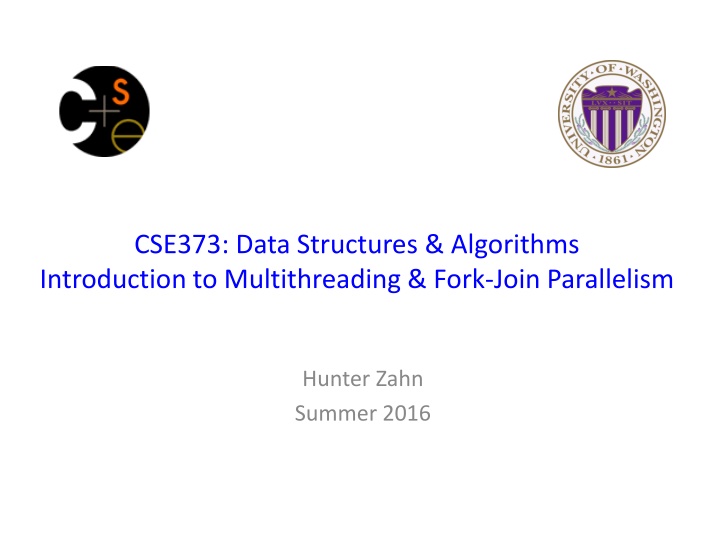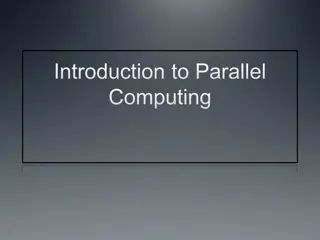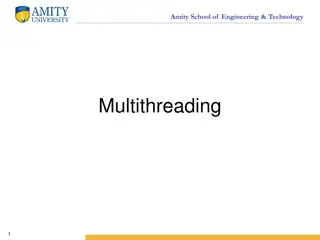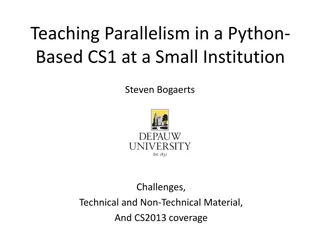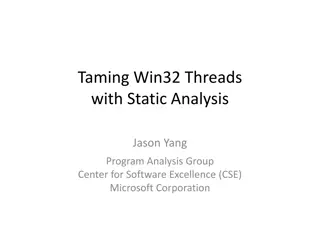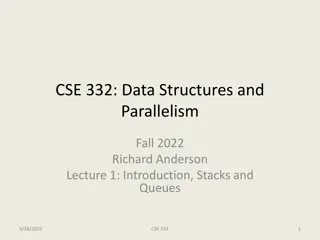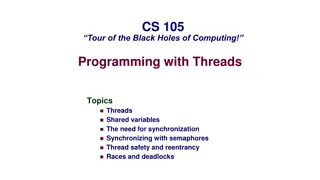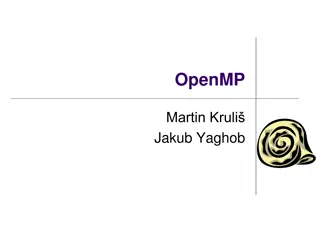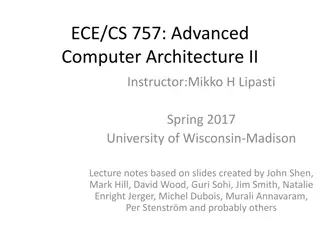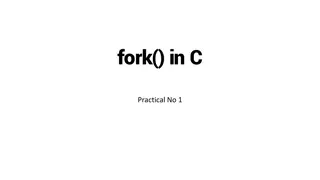Introduction to Multithreading & Fork-Join Parallelism
A look into the life and literary achievements of Mia Couto, a prominent Mozambican author known for his critical irrealism. Discover his background in journalism, his journey into writing, and his contributions to the literary world, including being the first African author to win the Latin Union literary prize. Explore his unique style and perspectives on magic realism.
Download Presentation

Please find below an Image/Link to download the presentation.
The content on the website is provided AS IS for your information and personal use only. It may not be sold, licensed, or shared on other websites without obtaining consent from the author.If you encounter any issues during the download, it is possible that the publisher has removed the file from their server.
You are allowed to download the files provided on this website for personal or commercial use, subject to the condition that they are used lawfully. All files are the property of their respective owners.
The content on the website is provided AS IS for your information and personal use only. It may not be sold, licensed, or shared on other websites without obtaining consent from the author.
E N D
Presentation Transcript
CSE373: Data Structures & Algorithms Introduction to Multithreading & Fork-Join Parallelism Hunter Zahn Summer 2016
Changing a major assumption So far most or all of your study of computer science has assumed One thing happened at a time Called sequential programming everything part of one sequence Removing this assumption creates major challenges & opportunities Programming: Divide work among threads of execution and coordinate (synchronize) among them Algorithms: How can parallel activity provide speed-up (more throughput: work done per unit time) Data structures: May need to support concurrent access (multiple threads operating on data at the same time) Fall 2015 CSE373: Data Structures & Algorithms 2
A simplified view of history Writing correct and efficient multithreaded code is often much more difficult than for single-threaded (i.e., sequential) code Especially in common languages like Java and C So typically stay sequential if possible From roughly 1980-2005, desktop computers got exponentially faster at running sequential programs About twice as fast every couple years But nobody knows how to continue this Increasing clock rate generates too much heat Relative cost of memory access is too high But we can keep making wires exponentially smaller (Moore s Law ), so put multiple processors on the same chip ( multicore ) Fall 2015 CSE373: Data Structures & Algorithms 3
What to do with multiple processors? Next computer you buy will likely have 4 processors Wait a few years and it will be 8, 16, 32, The chip companies have decided to do this (not a law ) What can you do with them? Run multiple totally different programs at the same time Already do that? Yes, but with time-slicing Do multiple things at once in one program Our focus more difficult Requires rethinking everything from asymptotic complexity to how to implement data-structure operations Fall 2015 CSE373: Data Structures & Algorithms 4
Parallelism vs. Concurrency Concurrency: Correctly and efficiently manage access to shared resources Parallelism: Use extra resources to solve a problem faster requests work resource resources Fall 2015 CSE373: Data Structures & Algorithms 5
Parallelism vs. Concurrency Concurrency is when two or more tasks can start, run, and complete in overlapping time periods. It doesn't necessarily mean they'll ever both be running at the same instant. Parallelism is when tasks literally run at the same time, eg. on a multicore processor. There is some connection: Common to use threads for both If parallel computations need access to shared resources, then the concurrency needs to be managed We will just do a little parallelism, avoiding concurrency issues Fall 2015 CSE373: Data Structures & Algorithms 6
An analogy CS1 idea: A program is like a recipe for a cook One cook who does one thing at a time! (Sequential) Parallelism: Have lots of potatoes to slice? Hire helpers, hand out potatoes and knives But too many chefs and you spend all your time coordinating Concurrency: Lots of cooks making different things, but only 4 stove burners Want to allow access to all 4 burners, but not cause spills or incorrect burner settings Fall 2015 CSE373: Data Structures & Algorithms 7
Parallelism Example Parallelism: Use extra resources to solve a problem faster Pseudocode for array sum Bad style for reasons we ll see, but may get roughly 4x speedup int sum(int[] arr){ res = new int[4]; len = arr.length; FORALL(i=0; i < 4; i++) { //parallel iterations res[i] = sumRange(arr,i*len/4,(i+1)*len/4); } return res[0]+res[1]+res[2]+res[3]; } int sumRange(int[] arr, int lo, int hi) { result = 0; for(j=lo; j < hi; j++) result += arr[j]; return result; } Fall 2015 CSE373: Data Structures & Algorithms 8
Concurrency Example Concurrency: Correctly and efficiently manage access to shared resources Pseudocode for a shared chaining hashtable Prevent bad interleavings (correctness) But allow some concurrent access (performance) class Hashtable<K,V> { void insert(K key, V value) { int bucket = ; prevent-other-inserts/lookups in table[bucket] do the insertion re-enable access to table[bucket] } V lookup(K key) { (similar to insert, but can allow concurrent lookups to same bucket) } } Fall 2015 CSE373: Data Structures & Algorithms 9
Shared memory The model we will assume is shared memory with explicit threads Not the only approach, may not be best, but time for only one Old story: A running program has One program counter (current statement executing) One call stack (with each stack frame holding local variables) Objects in the heap created by memory allocation (i.e., new) (nothing to do with data structure called a heap) Static fields New story: A set of threads, each with its own program counter & call stack No access to another thread s local variables Threads can (implicitly) share static fields / objects To communicate, write somewhere another thread reads Fall 2015 CSE373: Data Structures & Algorithms 10
Shared memory Threads each have own unshared call stack and current statement (pc for program counter ) local variables are numbers, null, or heap references Any objects can be shared, but most are not pc= Unshared: locals and control Shared: objects and static fields pc= pc= Fall 2015 CSE373: Data Structures & Algorithms 11
Our Needs To write a shared-memory parallel program, need new primitives from a programming language or library Ways to create and run multiple things at once Let s call these things threads Ways for threads to share memory Often just have threads with references to the same objects Ways for threads to coordinate (a.k.a. synchronize) A way for one thread to wait for another to finish [Other features needed in practice for concurrency] Fall 2015 CSE373: Data Structures & Algorithms 12
Java basics Learn a couple basics built into Java via java.lang.Thread But for style of parallel programming we ll advocate, do not use these threads; use Java 7 s ForkJoin Framework instead To get a new thread running: 1. Define a subclass C of java.lang.Thread, overriding run 2. Create an object of class C 3. Call that object s start method start sets off a new thread, using runas its main What if we instead called the run method of C? This would just be a normal method call, in the current thread Let s see how to share memory and coordinate via an example Fall 2015 CSE373: Data Structures & Algorithms 13
Parallelism idea Example: Sum elements of a large array Idea: Have 4 threads simultaneously sum 1/4 of the array Warning: This is an inferior first approach ans0 ans1 ans2 ans3 + ans Create 4 thread objects, each given a portion of the work Call start() on each thread object to actually run it in parallel Wait for threads to finish using join() Add together their 4 answers for the final result Fall 2015 CSE373: Data Structures & Algorithms 14
First attempt, part 1 class SumThread extends java.lang.Thread { int lo; // arguments int hi; int[] arr; int ans = 0; // result SumThread(int[] a, int l, int h) { lo=l; hi=h; arr=a; } public void run() { //override must have this type for(int i=lo; i < hi; i++) ans += arr[i]; } } Because we must override a no-arguments/no-result run, we use fields to communicate across threads Fall 2015 CSE373: Data Structures & Algorithms 15
First attempt, continued (wrong) class SumThread extends java.lang.Thread { int lo,int hi,int[] arr; // arguments int ans = 0; // result SumThread(int[] a, int l, int h) { } public void run(){ } // override } int sum(int[] arr){ // can be a static method int len = arr.length; int ans = 0; SumThread[] ts = new SumThread[4]; for(int i=0; i < 4; i++) // do parallel computations ts[i] = new SumThread(arr,i*len/4,(i+1)*len/4); for(int i=0; i < 4; i++) // combine results ans += ts[i].ans; return ans; } Fall 2015 CSE373: Data Structures & Algorithms 16
Second attempt (still wrong) class SumThread extends java.lang.Thread { int lo,int hi,int[] arr; // arguments int ans = 0; // result SumThread(int[] a, int l, int h) { } public void run(){ } // override } int sum(int[] arr){ // can be a static method int len = arr.length; int ans = 0; SumThread[] ts = new SumThread[4]; for(int i=0; i < 4; i++){// do parallel computations ts[i] = new SumThread(arr,i*len/4,(i+1)*len/4); ts[i].start(); // start not run } for(int i=0; i < 4; i++) // combine results ans += ts[i].ans; return ans; } Fall 2015 CSE373: Data Structures & Algorithms 17
Third attempt (correct in spirit) class SumThread extends java.lang.Thread { int lo,int hi,int[] arr; // arguments int ans = 0; // result SumThread(int[] a, int l, int h) { } public void run(){ } // override } int sum(int[] arr){// can be a static method int len = arr.length; int ans = 0; SumThread[] ts = new SumThread[4]; for(int i=0; i < 4; i++){// do parallel computations ts[i] = new SumThread(arr,i*len/4,(i+1)*len/4); ts[i].start(); } for(int i=0; i < 4; i++) { // combine results ts[i].join(); // wait for helper to finish! ans += ts[i].ans; } return ans; } Fall 2015 CSE373: Data Structures & Algorithms 18
Join (not the most descriptive word) The Thread class defines various methods you could not implement on your own For example: start, which calls run in a new thread The join method is valuable for coordinating this kind of computation Caller blocks until/unless the receiver is done executing (meaning the call to run returns) Else we would have a race condition on ts[i].ans This style of parallel programming is called fork/join Java detail: code has 1 compile error because join may throw java.lang.InterruptedException In basic parallel code, should be fine to catch-and-exit Fall 2015 CSE373: Data Structures & Algorithms 19
Shared memory? Fork-join programs (thankfully) do not require much focus on sharing memory among threads But in languages like Java, there is memory being shared. In our example: lo, hi, arrfields written by main thread, read by helper thread ansfield written by helper thread, read by main thread When using shared memory, you must avoid race conditions We will stick with join to do so Fall 2015 CSE373: Data Structures & Algorithms 20
A better approach Several reasons why this is a poor parallel algorithm 1. Want code to be reusable and efficient across platforms Forward-portable as core count grows So at the very least, parameterize by the number of threads int sum(int[] arr, int numTs){ int ans = 0; SumThread[] ts = new SumThread[numTs]; for(int i=0; i < numTs; i++){ ts[i] = new SumThread(arr,(i*arr.length)/numTs, ts[i].start(); } for(int i=0; i < numTs; i++) { ts[i].join(); ans += ts[i].ans; } return ans; } ((i+1)*arr.length)/numTs); Fall 2015 CSE373: Data Structures & Algorithms 21
A Better Approach 2. Want to use (only) processors available to you now Not used by other programs or threads in your program Maybe caller is also using parallelism Available cores can change even while your threads run If you have 3 processors available and using 3 threads would take time X, then creating 4 threads would take time 1.5X Example: 12 units of work, 3 processors Work divided into 3 parts will take 4 units of time Work divided into 4 parts will take 3*2 units of time // numThreads == numProcessors is bad // if some are needed for other things int sum(int[] arr, int numTs){ } Fall 2015 CSE373: Data Structures & Algorithms 22
A Better Approach 3. Though unlikely for sum, in general subproblems may take significantly different amounts of time Example: Apply method f to every array element, but maybe f is much slower for some data items Example: Is a large integer prime? If we create 4 threads and all the slow data is processed by 1 of them, we won t get nearly a 4x speedup Example of a load imbalance Fall 2015 CSE373: Data Structures & Algorithms 23
A Better Approach The counterintuitive (?) solution to all these problems is to use lots of threads, far more than the number of processors But this will require changing our algorithm [And using a different Java library] ans0 ans1 ansN ans 1. 2. Forward-portable: Lots of helpers each doing a small piece Processors available: Hand out work chunks as you go If 3 processors available and have 100 threads, then ignoring constant-factor overheads, extra time is < 3% Load imbalance: No problem if slow thread scheduled early enough Variation probably small anyway if pieces of work are small 3. Fall 2015 CSE373: Data Structures & Algorithms 24
Nave algorithm is poor Suppose we create 1 thread to process every 1000 elements int sum(int[] arr){ int numThreads = arr.length / 1000; SumThread[] ts = new SumThread[numThreads]; } Then combining results will have arr.length / 1000 additions Linear in size of array (with constant factor 1/1000) Previously we had only 4 pieces (constant in size of array) In the extreme, if we create 1 thread for every 1 element, the loop to combine results has length-of-array iterations Just like the original sequential algorithm Fall 2015 CSE373: Data Structures & Algorithms 25
A better idea + + + + + + + + + + + + + + + This is straightforward to implement using divide-and-conquer Parallelism for the recursive calls Fall 2015 CSE373: Data Structures & Algorithms 26
Divide-and-conquer to the rescue! class SumThread extends java.lang.Thread { int lo; int hi; int[] arr; // arguments int ans = 0; // result SumThread(int[] a, int l, int h) { } public void run(){ // override if(hi lo < SEQUENTIAL_CUTOFF) for(int i=lo; i < hi; i++) ans += arr[i]; else { SumThread left = new SumThread(arr,lo,(hi+lo)/2); SumThread right= new SumThread(arr,(hi+lo)/2,hi); left.start(); right.start(); left.join(); // don t move this up a line why? right.join(); ans = left.ans + right.ans; } } } int sum(int[] arr){ SumThread t = new SumThread(arr,0,arr.length); t.run(); return t.ans; } The key is to do the result-combining in parallel as well And using recursive divide-and-conquer makes this natural Easier to write and more efficient asymptotically! Fall 2015 CSE373: Data Structures & Algorithms 27
Divide-and-conquer really works The key is divide-and-conquer parallelizes the result-combining If you have enough processors, total time is height of the tree: O(log n) (optimal, exponentially faster than sequential O(n)) Next lecture: consider reality of P << n processors + + + + + + + + + + + + + + + Fall 2015 CSE373: Data Structures & Algorithms 28
Being realistic In theory, you can divide down to single elements, do all your result-combining in parallel and get optimal speedup Total time O(n/numProcessors + logn) In practice, creating all those threads and communicating swamps the savings, so: Use a sequential cutoff, typically around 500-1000 Eliminates almost all the recursive thread creation (bottom levels of tree) Exactly like quicksort switching to insertion sort for small subproblems, but more important here Do not create two recursive threads; create one and do the other yourself Cuts the number of threads created by another 2x Fall 2015 CSE373: Data Structures & Algorithms 29
Being realistic, part 2 Even with all this care, Java s threads are too heavyweight Constant factors, especially space overhead Creating 20,000 Java threads just a bad idea The ForkJoin Framework is designed to meet the needs of divide-and-conquer fork-join parallelism In the Java 7 standard libraries Library s implementation is a fascinating but advanced topic Next lecture will discuss its guarantees, not how it does it Names of methods and how to use them slightly different Fall 2015 CSE373: Data Structures & Algorithms 30
